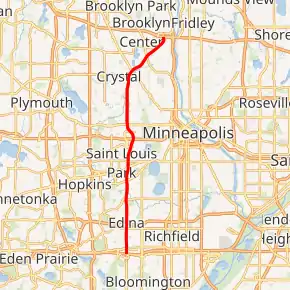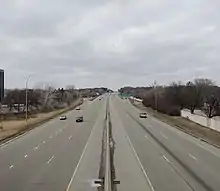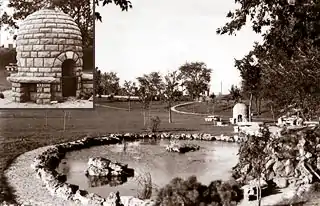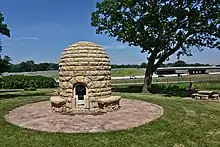Minnesota State Highway 100
Minnesota State Highway 100 (MN 100) is a state highway in the Twin Cities region of Minnesota, which runs from its interchange with Interstate 494 (I-494) in Bloomington and continues north to its northern terminus at its interchange with I-694 in Brooklyn Center. The southern end of MN 100 continues in Bloomington as Normandale Boulevard (County Road 34, CR 34). At the north end, the main line of MN 100 merges with I-694 in Brooklyn Center. The route is 16 miles (26 km) in length.
| ||||
|---|---|---|---|---|

MN 100 highlighted in red | ||||
| Route information | ||||
| Maintained by MnDOT | ||||
| Length | 16.178 mi[1] (26.036 km) | |||
| Existed | 1934–present | |||
| Major junctions | ||||
| South end | ||||
| ||||
| North end | ||||
| Location | ||||
| Counties | Hennepin | |||
| Highway system | ||||
| ||||
Route description
MN 100 serves as a north–south arterial route in the western suburbs of the Twin Cities. The roadway serves the communities of Bloomington, Edina, St. Louis Park, Golden Valley, Crystal, Robbinsdale and Brooklyn Center. MN 100 is constructed to freeway standards. The route is located in Hennepin County.

History
Routing as a beltway
The route was authorized in 1934. MN 100 was originally meant as a beltway around the Twin Cities (presumably the reason for the round number) and actually achieved that status for about 20 years in the mid-20th century (although it wasn't a full freeway).
All of the current MN 100 was also in the original route. Starting from the current southern terminus, Old MN 100 was concurrent eastward with a pre-I-494 MN 5 past the Minneapolis-Saint Paul International Airport to its intersection with MN 55. Old MN 100 then continued east concurrent with MN 55 over the Mendota Bridge, then along current MN 62 through Mendota Heights, then MN 100 went on Southview Boulevard into South St. Paul. Then old MN 100 followed Grand Avenue downhill, until it met old MN 56 on Concord Street. Then old MN 100 followed south on Concord Street into Inver Grove Heights, then east over the railroad bridge into Newport; and then turning north onto Century Avenue in Woodbury, which feeds into current MN 120 north of I-94 in Maplewood / Oakdale. Old MN 100 then turned west upon County Road F and north along White Bear Avenue to meet up with and concurrent westward with old MN 96 (the section of which is now County Rd 96 in Vadnais Heights and Shoreview). Old MN 100 then turned south briefly along U.S. Highway 8 (US 8, now a city maintained street in New Brighton), then old MN 100 carried on westward along the current routing of I-694 through New Brighton and Fridley to meet back at its present-day northern terminus at Brooklyn Center.
Due to traffic pattern changes over the years, it is no longer possible to directly follow the path of old MN 100. Small detours are necessary which involve the use of exits 40 and 60 of the present I-494/I-694 beltway.
Lilac Way

The original construction of MN 100 started in 1935, as a New Deal project. The project was a cooperative venture between the Works Progress Administration (WPA) and the Minnesota Highway Department, and was the largest WPA project in the state. The demand for the highway came out of growing pains in the Twin Cities during the 1920s, when Minneapolis city streets were congested and suburban roads were poorly maintained dirt roads. The plan for a beltway around the Twin Cities incorporated existing roads, both paved and unpaved. A new section of highway, between MN 5 (now I-494 and MN 5) in Edina and then-US 52 (now CR 81) in Robbinsdale was needed to complete the beltway. As such, it was planned as a state-of-the-art highway, with two lanes in each direction separated by wide medians, bridges at major intersections and railroad crossings, and the first cloverleaf interchanges in Minnesota.
Carl Graeser, the highway engineer and Arthur R. Nichols, a landscape architect, teamed up to design the highway. A large number of WPA workers worked on the construction of the highway. Since the WPA was designed to keep a large number of workers busy, a lot of hand digging was done as opposed to using bulldozers. Cloverleaf interchanges were built at MN 7, US 12 (now I-394 and US 12) and MN 55 (Olson Highway).
The landscaping of the highway was meant to give the highway a parkway-like experience. As such, it was built with a wider right-of-way than the typical highway. The Golden Valley Garden Club supported efforts to plant lilacs along the highway and the Minneapolis Journal coined the name "Lilac Way". Eventually, 7,000 lilacs were planted. In addition, the builders built five wayside parks along the way. These parks were intended for picnicking and featured stone picnic tables, beehive barbecues, waterfalls and so on. These fixtures provided work for local stonemasons, as another part of the WPA project. The western leg was completed in 1940, but further construction on the beltway was halted with the United States' entry into World War II. An extension from then-US 52 (now CR 81) in Robbinsdale to US 10 (near present-day I-35W) in New Brighton was built with federal aid to provide access to industrial areas as an asset to the manufacture of "essential war materials".

Graeser Park in Robbinsdale and the St. Louis Park Roadside Park (near the southeast corner of MN 100 and MN 7) are the only remaining roadside parks from the 1930s that are still mostly intact after widening of MN 100.
The beltline was not completed until 1950. At that point, demand from the baby boom led to rapid growth in the suburbs.
In 2009, restoration of the St. Louis Park Roadside Park was completed and the park renamed Lilac Park. As part of the restoration project, a beehive fireplace from the old Lilac Park to the north was transferred and restored. A new bicycle/walkway path constructed within the park connects the park to the Southwest LRT Trail.
Recent construction

Conversion of the remaining portion of the road into a freeway is complete. In 2004, construction was finished on the northern portion of MN 100 between I-394 and I-694, making MN 100 a freeway for its entire length.
The section between MN 7 and I-394 in St. Louis Park, the oldest part of the freeway, was reconstructed into a 6-lane freeway, completed in Nov. 2016.[2] MN 100 is now 6 lanes from just north of the I-494 interchange in Edina, to the interchange at Bottineau Boulevard (County Road 81) in Robbinsdale.
As part of these projects, 2 of the original 3 cloverleaf intersections were replaced. The cloverleaf at MN 55 in Golden Valley was changed and rebuilt in 2004 as a signalized single-point urban interchange (SPUI). The cloverleaf at MN 7/CR 25 was replaced with a folded diamond interchange. The remaining cloverleaf is at the I-394 interchange.
The original Lilac Park in St. Louis Park was also lost to this construction. Several of the park's WPA-built stone picnic tables and a beehive fireplace were saved and relocated to the remaining portion of St. Louis Park Roadside Park, which was then renamed Lilac Park.[3]
Exit list
The entire route is in Hennepin County. All exits are unnumbered.
| Location | mi[1] | km | Destinations | Notes | |
|---|---|---|---|---|---|
| Bloomington | 0.00 | 0.00 | I-494 exit 7; southern terminus of MN 100. | ||
| Edina | 0.359 | 0.578 | Industrial Boulevard, West 77th Street | ||
| 1.184 | 1.905 | West 70th Street | |||
| 2.115 | 3.404 | ||||
| 2.601 | 4.186 | Benton Avenue | Southbound exit and northbound entrance | ||
| 3.549– 3.879 | 5.712– 6.243 | ||||
| St. Louis Park | 4.931 | 7.936 | |||
| 5.456 | 8.781 | West 36th Street | |||
| 5.875 | 9.455 | ||||
| 6.208 | 9.991 | ||||
| 7.137– 7.183 | 11.486– 11.560 | Barry Street, Cedar Lake Road, Westside Drive | Northbound exit signed Barry Street and Cedar Lake Road; southbound exit signed Westside Drive and Cedar Lake Road | ||
| Golden Valley | 7.785 | 12.529 | I-394 exit 5. | ||
| 8.322 | 13.393 | ||||
| 8.902 | 14.326 | SPUI interchange; interchange reconstructed in 2003 | |||
| 9.900 | 15.933 | ||||
| Crystal | 11.435 | 18.403 | 36th Avenue North | Converted from an at-grade to an interchange in 2003; former MN 278 | |
| 12.162 | 19.573 | Interchange reconstructed in 2003 | |||
| Robbinsdale | 12.544– 12.565 | 20.188– 20.221 | Access from MN 100 north to CR 81 south and CR 81 north to MN 100 south is via CR 9; converted from an at-grade to an interchange in 2003 | ||
| Brooklyn Center | 13.317 | 21.432 | France Avenue | Converted from an at-grade to an interchange in 2003 | |
| 14.034 | 22.586 | ||||
| 15.018 | 24.169 | ||||
| 15.785 | 25.403 | Northbound exit and southbound entrance | |||
| 16.178 | 26.036 | I-694 exit 35A; northbound exit and southbound entrance; northern terminus of MN 100. Road continues north as Humboldt Avenue. | |||
| 1.000 mi = 1.609 km; 1.000 km = 0.621 mi | |||||
References
- Staff (September 9, 2009). "Metro Division Trunk Highway Log Point" (PDF). Minnesota Department of Transportation. pp. 168–72. Retrieved August 31, 2011.
- Otarola, Miguel (2016). "Drivers and the west metro rejoice: At last, major construction on Hwy. 100 is over" (html). StarTribune.
- http://www.deadpioneer.com/articles/MN100/stlouislilac/stlouislilac.html
General references
- Riner, Steve (July 27, 2003). "Details of Routes 75-100". Retrieved September 18, 2004.
- Froehlig, Adam (March 18, 2003). "Minnesota Highway 100 Photos". Retrieved September 18, 2004.
- Staff (2005). "Minnesota Statutes 161.115, Subdivision 143". Minnesota Statutes. Office of Revisor of Statutes, State of Minnesota. Retrieved April 12, 2006.
- Twin Cities Public Television (2001). Highway 100: Lilac Way (Documentary). St. Paul, MN: Twin Cities Public Television. Archived from the original on November 5, 2009. Retrieved August 4, 2010.
- Staff. "Assessment + Analysis: Highway 100 – Lilac Way". New Deal Roadside Landscape Features. National Park Service. Retrieved April 12, 2006.
- Staff. "Highway 100 Temporary Lane in St. Louis Park". Minnesota Department of Transportation. Archived from the original on January 18, 2006. Retrieved May 31, 2006.
- Staff. "The Beehive". St. Louis Park Historical Society. Archived from the original on January 10, 2011. Retrieved August 20, 2010.
